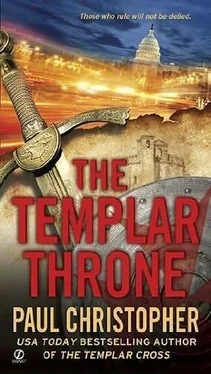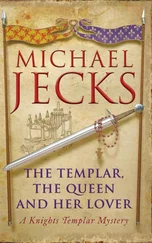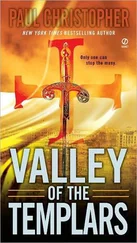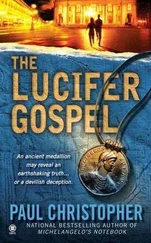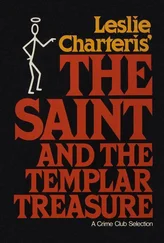Paul Christopher - The Templar throne
Здесь есть возможность читать онлайн «Paul Christopher - The Templar throne» весь текст электронной книги совершенно бесплатно (целиком полную версию без сокращений). В некоторых случаях можно слушать аудио, скачать через торрент в формате fb2 и присутствует краткое содержание. Жанр: Триллер, на английском языке. Описание произведения, (предисловие) а так же отзывы посетителей доступны на портале библиотеки ЛибКат.
- Название:The Templar throne
- Автор:
- Жанр:
- Год:неизвестен
- ISBN:нет данных
- Рейтинг книги:4 / 5. Голосов: 1
-
Избранное:Добавить в избранное
- Отзывы:
-
Ваша оценка:
- 80
- 1
- 2
- 3
- 4
- 5
The Templar throne: краткое содержание, описание и аннотация
Предлагаем к чтению аннотацию, описание, краткое содержание или предисловие (зависит от того, что написал сам автор книги «The Templar throne»). Если вы не нашли необходимую информацию о книге — напишите в комментариях, мы постараемся отыскать её.
The Templar throne — читать онлайн бесплатно полную книгу (весь текст) целиком
Ниже представлен текст книги, разбитый по страницам. Система сохранения места последней прочитанной страницы, позволяет с удобством читать онлайн бесплатно книгу «The Templar throne», без необходимости каждый раз заново искать на чём Вы остановились. Поставьте закладку, и сможете в любой момент перейти на страницу, на которой закончили чтение.
Интервал:
Закладка:
The tour boat slowed as it made a wheeling turn out into the broad reach of the Grand Canal, and even in the rain Holliday got his bearings straight; they were heading east and slightly north, a course that would take them to the Rialto Bridge and their hotel. He was tempted to bribe the man in the sailor's cap to let them off at the dock beside the bridge, but Holliday followed his better judgment and said nothing; there was nothing at the hotel they couldn't live without, and whoever was on their trail was almost sure to have the place under surveillance.
That was the question of the day: Who was on their tail and why? The Peseks didn't kill people just for the hell of it; someone was paying them. Holliday was on the trail of an obscure Templar knight who was using an even more obscure navigation instrument; it might upset a historical applecart or two, but it wasn't earth-shaking. Sister Meg was filling in the blanks in the life of a mother superior at a relatively obscure convent of Irish nuns in a Czech convent; hardly the stuff of James Bond and Jason Bourne.
At first he'd thought it was the Vatican Secret Service, Sodalitium Pianum, but that didn't make sense either. The bald guy in Prague was clearly a contract investigator, and the Peseks were hirelings, as well, and as Holliday knew from personal experience, the Vatican had plenty of assassins of their own. Somewhere in the lives of two dead lovers from four hundred years ago there was an answer.
The tour boat and its well-oiled partying passengers made another turn, this time to the right onto a narrower canal that ran alongside the elegant facade of a massive old palazzo, its half-submerged foundations stained a crumbling, putrid brown by the effluent in the water and a thousand years of twice-daily tidal fluctuations.
Sister Meg tugged at his arm.
"What?"
"I just overheard a conversation; I know where we're going."
"Where?"
"Some place called the Isola di San Michele. That's the third reference to Saint Michael that's come our way."
"Maybe it's an omen," Holliday said and smiled.
"You're making fun of me," said the nun, color rising in her cheeks.
"I'm making a joke," said Holliday, exasperated.
"At my expense."
"Don't be so sensitive," said Holliday. "We don't have time for it. There's a dead kid back there with a hole in his head, remember?"
Sister Meg lapsed into silence. Overhead the rattling of the rain on the canvas canopy slowed and then stopped altogether. As quickly as the storm had come it vanished, the clouds rolling back and letting in broad, slanting beams of sunlight. On their left the canal widened considerably and a forest of masts appeared-a large marina, and beyond it the sudden sweep of the Venice ship channel between the islands of the archipelago and the mainland.
"Sacca della Misericordia," said the tired man in the sailor's hat, still slumped on his stool.
"Sacca," said Holliday. "What the hell is a sacca, a bag of some kind? That doesn't make any sense."
"Cove, I think," said Sister Meg. "Cove of the sheltering virgin."
The man in the hat pointed to an island to their right about half a mile out into the broad ship channel. "Isola di San Michele, una isola del muerte."
Holliday squinted. The island looked almost artificial, a wall surrounding it with towers at the corners. A prison?
"Cimetero di Napoleon," the tour guide explained.
"It's a cemetery," said Holliday. "We're going on a tour of a cemetery."
13
At one time in its history the Isola di San Michele had actually been two islands divided by a canal. During Napoleon's brief occupation of Venice he decreed, quite rightly, that the mainland cemeteries were unsanitary, their swampy "vapors" almost certainly the cause of the endless rounds of cholera and plague epidemics that regularly visited the tiny republic on the shore of the Adriatic. If there was one thing Napoleon was good at, it was cemeteries. He'd moved dozens of local cemeteries during the reconstruction of imperial Paris and he did the same thing in Venice.
Thousands of bodies were exhumed, packed in ossuary boxes and taken to the islands. The canal was filled in, making the two islands into one, and a wall was built around the entire perimeter.
Within a few years new burials took precedence over the old and special funeral gondolas plied the waters between the city and the island with the regularity of a bus route. Napoleon's prim, gardenlike cemetery with its parks, lines of tall trees and statuary became a cluttered slum of headstones and monuments that ranged from the simple and plain to the ornately vulgar.
Over time the "Island of the Dead" attained a certain romantic cachet and it became the final destination for a broad spectrum of the famous and the infamous, from Joseph Brodsky, the exiled Russian poet; Ezra Pound, the exiled American poet; Igor Stravinsky, the composer; and Sergei Pavlovich Diaghilev, the dance impresario and founder of the Ballets Russe. A little more than two hundred years from its beginnings the island had apparently now become a tourist attraction.
The boat edged around to the near side of the island and a small wharf. With the sun shining brightly out of a clearing sky, the passengers obediently trudged off the barge and headed through a gate in the wall that led to the cemetery.
"Now what?" Sister Meg asked.
"We have to get to the mainland," said Holliday as they followed some stragglers along a broad gravel pathway. The cemetery had been subdivided into immense neat squares, each square crammed with hundreds of headstones, new and old. From the looks of things there were only a few real mourners; the rest were tourists taking photographs and peering at inscriptions.
"I think the tour is heading back to the city when we're finished here. I heard people talking about getting to the hotel in time for dinner."
"There has to be another way off the island," said Holliday. "They're almost certain to have found the kid by now."
"It looked like there was another little dock farther along the wall," suggested Meg. "Maybe we can find someone to rent us a boat or something."
The path they were on ended at the facade of San Michele in Isola, an early Renaissance church fitted into one corner of the island. There was a redbrick cloister attached to one side of the church. Sandaled, dark-robed Franciscan monks were tending the flower beds around the church. More Franciscans, thought Holliday, the male counterparts to the Poor Clare nuns of the St. Agnes convent in Prague. A Franciscan conspiracy? That was right up there with The Da Vinci Code on the religious conspiracy paranoia scale. The Vatican might be a hotbed of conspiracy, but all of them were inevitably and invariably about money.
He shook the feeling off and looked for a way around the church. In the far corner, against the brick wall of the cemetery, they found a simple wooden door. Checking to see if anyone was watching, Holliday gently tried the latch. The door creaked open on rusty hinges. Just beyond the doorway he caught the ripe smell of rotting wood and seaweed.
"Come on," he said, and stepped through the doorway.
They found themselves standing on a narrow breakwater. The only thing between them and the dark waters of the ship channel was a row of tarred beams creating an artificial barrier against erosion.
To their right was the rear facade of the church, to the left a small brick boathouse. In front of the boathouse was an old cabin cruiser that looked almost homemade-sheets of plywood painted flat, robin's egg blue for the stubby hull, with more painted plywood for a simple deckhouse.
The tired-looking craft was powered by a big Mercury outboard clamped to the frail-looking transom. The boat was hugely overpowered. An engine that size at full throttle would tear itself off the transom. The name on the stern identified the ramshackle boat as the Casanova III and its home port as Venice. There were half a dozen long fishing poles scattered on the roof of the deckhouse, and the afterdeck itself was cluttered with more fishing equipment, most of it obviously untended for a long time. A wooden five-spoked wheel was positioned on the cabin bulkhead and a set of controls was bolted to the port gunwale. A narrow door led into the cabin proper.
Читать дальшеИнтервал:
Закладка:
Похожие книги на «The Templar throne»
Представляем Вашему вниманию похожие книги на «The Templar throne» списком для выбора. Мы отобрали схожую по названию и смыслу литературу в надежде предоставить читателям больше вариантов отыскать новые, интересные, ещё непрочитанные произведения.
Обсуждение, отзывы о книге «The Templar throne» и просто собственные мнения читателей. Оставьте ваши комментарии, напишите, что Вы думаете о произведении, его смысле или главных героях. Укажите что конкретно понравилось, а что нет, и почему Вы так считаете.
